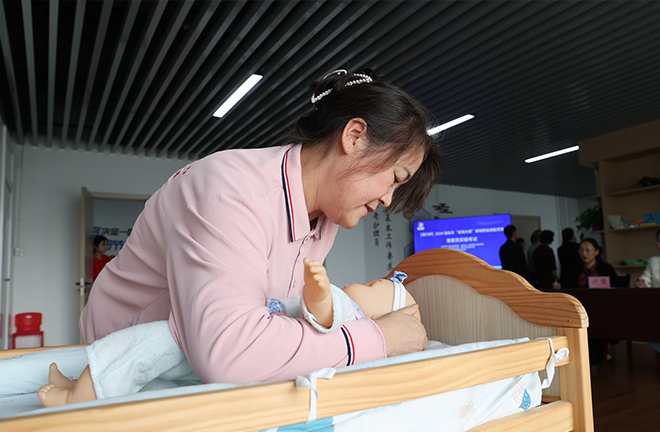Innovative practices improve employment quality of migrants

A domestic worker participates in a domestic service skills competition in Huaibei, Anhui Province, on Oct. 12, 2024. Photo: IC PHOTO
Employment is the fundamental component of the people’s wellbeing. As the digital economy develops rapidly, new technologies such as the internet, big data, and artificial intelligence have spawned a variety of new occupations, including ride-hailing drivers, food delivery workers, and liver-streamers, not only breaking free from temporal and spatial constraints, but also providing the majority of migrant workers with more job opportunities. Particularly, these technological advancements have opened up more flexible career development paths for migrants.
Increasing job opportunities
According to the Ninth National Survey on the Status of the Workforce, the number of workers involved in new employment forms reached 84 million in 2022, accounting for approximately 21% of the total workforce. Currently, the total number of migrant workers in China stands at 297 million, with an increasing proportion engaged in new employment forms. With over 60% of these new workers coming from the agricultural population, the new employment forms not only provide migrant workers with more job opportunities but also inject new momentum into China’s new urbanization efforts.
The rapid development of the digital economy has brought new opportunities to migrant workers, but it has also introduced new challenges. Systematic solutions are urgently needed in expanding employment channels, improving rights protection mechanisms, and upgrading service systems, among other aspects.
Digital platforms have spawned new employment forms like on-demand delivery, shared maintenance, and live-streaming marketing, expanding job channels for migrant workers. From an employment structure perspective, digital platforms have facilitated the expansion and upgrading of the service sector, prompting more migrant workers to move to tertiary industries.
According to the National Bureau of Statistics’ 2023 Migrant Workers Monitoring Survey Report, migrant workers accounted for over 53.8% of the workforce in the tertiary sector, reflecting a sustained rise in comparison to the employment proportion in the secondary industry. In practice, Hangzhou, in east China’s Zhejiang Province, has created opportunities for more migrant workers to secure stable incomes through flexible jobs like ride-hailing and instant delivery via digital platforms. Data from a major food delivery platform shows that 72% of its registered delivery workers are from rural areas. In terms of income, the same report indicates that the average monthly income of migrant workers in 2023 reached 5,441 yuan, 1,310 yuan higher than their peers employed locally.
Institutional innovation
However, merely increasing employment opportunities is not enough. Institutional innovation is required to better protect migrant workers’ rights and interests. In recent years, local governments across China have actively explored new models of labor relations governance suited to new forms of employment.
In 2022, eight departments in south China’s Guangdong Province, including its human resources and social security department and development and reform commission, jointly issued guidelines for safeguarding the rights and interests of workers in new employment forms. In 2023, the province’s human resources and social security department further issued a reference document for agreements on new labor relations in emerging employment forms, providing scientific guidance for enterprises to employ workers in compliance with the law.
Zhejiang Province has crafted a public service model dubbed “Employed in Zhejiang,” which leverages digital employment scenarios to streamline formalities and implement beneficial policies for workers.
Meanwhile, local authorities have worked to improve the social security system, providing basic social security in eldercare and medical care for workers in new employment forms, helping them better integrate into urban life. In Shenzhen, Guangdong, measures have been introduced to allow workers in new employment forms to enroll in social insurance schemes where they work and make contributions via mobile apps, simplifying the process and making social insurance participation more flexible and convenient.
To ensure the stable and sustainable employment of migrant workers, it is crucial to further establish and refine the employment service system. As the digital economy continues to advance, various online platforms are reshaping traditional labor relations, necessitating innovation and upgrades to the employment service system.
In response, local governments have actively pursued innovations in digital employment services. For instance, Jiangsu Province in eastern China has developed the smart employment service cloud platform “Employed Right in Jiangsu.” In the first half of 2024, the platform posted over 5.5 million job openings, garnered more than 40 million visits, and assisted 3.48 million job seekers.
In southwest China’s Chongqing Municipality, the “Spring Breeze Action +” service model introduced a smart employment system featuring the “Chongqing Digital Brain for Employment,” which enables precise profiling and dynamic monitoring of key demographic groups.
Efforts are also underway to promote the digital transformation of skills training. Many provinces have launched a “Migrant Worker Skills Training Cloud Platform” to consolidate high-quality training resources and provide online vocational training. In 2023, over 18 million migrant workers across the country received government-subsidized training, significantly enhancing their competitiveness in the labor market.
Promoting migrant workers’ participation in new forms of employment and helping them secure desirable jobs not only supports economic transformation and upgrading but also opens new avenues for integrated urban-rural development. Looking ahead, government departments should further refine policy frameworks, enhancing support in areas such as tax exemptions, entrepreneurship, and skills training. Platform enterprises must fulfill their social responsibilities by strengthening mechanisms to protect workers’ rights and interests, thereby creating better conditions for their employees’ development. Additionally, all sectors of society should collaborate to foster an environment conducive to the development of new employment forms.
Yao Jinhai is a professor from the School of Economics and Management at Huzhou College in Zhejiang Province. Li Maochun is an associate professor from the Party School of the CPC Jiangxi Provincial Committee (Jiangxi Academy of Governance).
Edited by CHEN MIRONG

 PRINT
PRINT CLOSE
CLOSE